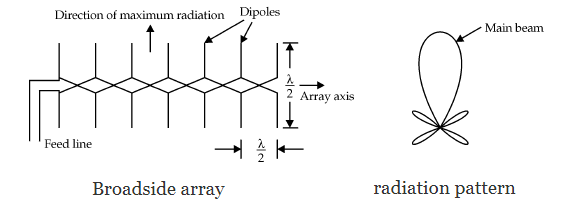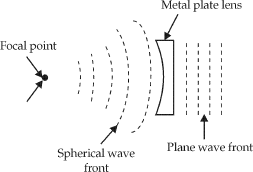Table of Contents
Antenna Array
An antenna array is a system of similar antennas oriented similarly to get greater directivity in the desired direction. It may be defined as, “A radiating system consisting of several spaced and properly phased radiators.”
An array of radiators is defined as a system of antennas which are similar or non-similar and either similarly oriented or differently oriented. Arrays are used to increase directivity and gain.
An array antenna is one that consists of a group of elements arranged linearly or in a plane. When an antenna element is bi-directional or multi-directional in its radiation characteristics, an array of such elements yields a uni-directional pattern. An array is said to be linear if the elements are arranged along a straight line with equal spacing.
Types of Arrays
Arrays are divided into:
- Broadside array
- End-fire array
- Collinear Array
- Parasitic Array
Broadside Array
Broadside array is an array which gives a radiation pattern whose main beam is perpendicular to the axis of the array.
In a wider sense, broadside array is a linear or a planar array antenna whose direction of maximum radiation is perpendicular to the line or plane of the array.
Salient features of broadside arrays
- A number of dipoles of equal size are used.
- The elements are spaced equally.
- All the dipoles are fed in the same phase.
- The null-to-null beamwidth of broadside array.
Beam width between first Nulls (BWFN)= \frac{2\lambda }{Nd}
whereλ = wavelength N = number of elements d = spacing between the elements
- The length of the broadside array can be 2 to 10λ.
- Typical spacing between the elements varies from λ/2 to λ.
- The number of elements to be used depends on the beam width requirement, cost, and space available.
- A broadside array is often used along with a reflector antenna. The back lobe is now reflected forward and adds to the forward lobe.
- When a broadside array is used with a reflector, it is possible to improve its gain and directivity and the broadside array becomes uni-directional.
- This array is often used in overseas broadcast systems.
- It is used for LF, MF, HF and the higher band of frequencies.
- A typical broadside array and its radiation pattern is shown in the figure below

End-Fire Array
An end-fire array is an array that gives a radiation pattern whose main beam is along the axis of the array. In a wider sense, the end-fire array is a linear or planar antenna whose direction of maximum radiation is along the line or in the plane of the array.
Salient features of the end-fire array
- A number of dipoles or elements of equal size are used.
- The elements are equally spaced.
- The elements are fed with different phases.
- The additional phase for each element is given by
Where,
k=\frac{2\pi }{\lambda }d = spacing, ϕ is the angle between the line of observation and axis of the array.
- Null-to-Null to beam width of an end-fire array is
Beam width between first Nulls (BWFN) = 2\sqrt{\frac{2\lambda }{Nd}}
- In this, the pattern is uni-directional.
- The physical arrangement of the elements in the end-fire array is the same as that of the broadside array.
- The number of elements to be used depending on the beam width requirements, cost, and space available. These are often used in LF, MF, HF and the higher band of frequencies.
- These arrays are used for point-to-point communications and in overseas broadcasting systems.
- In this array, the elements are spaced at λ/4 or 3 λ/4.
- A typical end-fire structure and its radiation pattern is shown in the figure below
Related Post
Difference between Broadside and End fire array
Collinear Array
In collinear array, the antennas are arranged co-axially i.e. antennas are mounted end-to-end in a single line. In other words, one antenna is stacked over another antenna. The individual elements are fed with equal phase currents as is the case in the broadsided arrays. A collinear array is a broadside radiator, in which the direction of maximum radiation is perpendicular to the line of the antenna. This arrangement gives radiation pattern which, when viewed through the major axis, closely resembles the radiation pattern of a broadside array.
In the collinear array, the direction of maximum radiation is perpendicular to the axis of array. So the radiation pattern of the collinear array and the broadside array is very much similar but the radiation pattern of the collinear array has circular symmetry with the main lobe perpendicular everywhere to the principal axis. Thus the collinear array is also called an omnidirectional array or broadcast array.

The gain of the collinear array is maximum if the spacing between the elements is of the order of 0.3 λ to 0.5 λ. But this small spacing introduces constructional and feeding problems. To overcome this difficulty, the elements of the array are operated with their ends very close to each other by connecting ends by an insulator.
The power gain of the collinear array does not increase in proportion with the number of elements. For example, for 2-element array power gain is 1.9 dB but for 4 – element array it is not equal to twice of the power gain for the 2-element array, but it is simply equal to 4.3 dB. Thus a collinear array with more than 4-elements is not practically used as power gain is not sufficient. But the practically two-element collinear array is used as it allows multiband operation. It is generally known as two half-waves in phase.
Parasitic Array
In order to overcome feeding problems of the antenna, sometimes, the elements of the array are fed through the radiation from the nearby element. The array of antennas in which the parasitic elements get the power through electromagnetic coupling with a driven element which is in proximity with the parasitic element is known as a parasitic array.
The simplest form of the parasitic array consists of one driven element and one parasitic element. In multielement parasitic array, there may be one or more driving elements and also one or more parasitic elements. So in general the multielement parasitic array is the array with at least one driven element and one or more parasitic elements.
The common example of the parasitic array with linear half-wave dipoles as elements of an array is Yagi-Uda array or simply Yagi antenna.




